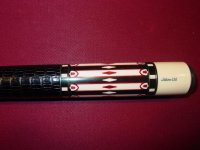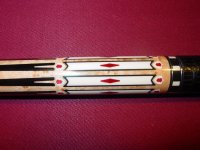Can you repeat all that again please? I was mesmerized by the women in your advatar.Ivory comes from animal teeth and tusk and has been used traditionally by many different cultures. It can be very difficult to tell real ivory from synthetic or fake ivory. The problem is that real ivory varies so much in color and grain. There are ways of telling fake ivory from real ivory just by performing a few tests. Of course to be 100% sure a chemical test has to be done. Ivory was used for centuries in Chinese dragon artwork and Eskimo Carving.
Most fake ivory is made up of either plastic or a resin of old ivory that is ground down and mixed with another synthetic. Bone carvings are also easily confused with ivory carvings. Bone carvings are generally have far less value than those of ivory. Plastic and resins are usually smoother than real ivory. Looking at bone under magnification you will see a lot of pitting something that real ivory will not have.
The hot pin test can help you determine the difference between plastic, synthetic, bone and ivory. Its best to perform this test on the bottom of the object that is not visible as it may cause damage to plastic objects. Heat a needle until it is extremely hot than touch the needle against the object you are testing. A hot needle can not penetrate real ivory like it will a plastic or resin. When you touch bone with a hot needle smell the area that you touched. It should have a very unique smell like burning hair. When you touch ivory with a hot needle you will smell something more like a burning teeth dentist office type smell. Passing this test is a pretty good indication that you have real ivory.
You are using an out of date browser. It may not display this or other websites correctly.
You should upgrade or use an alternative browser.
You should upgrade or use an alternative browser.
How do you tell if a cue has real Ivory in it?
- Thread starter Gatz
- Start date
No there isn't any test that can be conducted once finish is put on the cue except to remove the finish and test it. The highest grades of Ivory also doesn't have any noticeable grain in it either. Some of the ferrules I recently made from a section of Tusk don't show any grain at all. It all depends upon far to many factors than I have time to list, but here are a few, whether it is soft or hard Ivory, the climate that the Elephant
was located in, and what part of the Tusk the Ivory was cut from.
Now I am not in anyway an expert, however, I suspect that I have as much or more experience with Ivory as most on the forum.
Craig is not expert, but I do have some knowledge!!
Thanks for the info Craig. Ive always thought that ivory with that sweet grain was the best to play with. I have a shaft with an ivory ferrule that has almost no grain that I was thinking about selling, but now that I know its stronger, I think Ill just keep it. Thanks bud!
Joe
Ron F...That may just be the fanciest Schon I've ever seen. Nice cue!
Scott Lee
www.poolknowledge.com
Scott Lee
www.poolknowledge.com
My Ltd with 56 ivory inlays (excluding the rings) and 56 pink ivory inlays. If you have the right light and hold the cue a certain way you can see grain in some of the inlays.
Ron F
View attachment 135028
View attachment 135029
The only way I know to tell is simply by knowing ivory well enough to distinguish it from anything else. I do see collectors & serious cue buyers shining black lights over cues they are interested in buying. Besides looking for sharpie marker lines, I don't know what else they could be looking for except authenticity of ivory. Ivory glows, just like our teeth do in a nite club with black lights. It's something to do with organic materials. Synthetics & plastic usually do not, unless they have some kind of flourescent agent mixed in to make it glow. I could be wrong. I never cared enough to experiment & test ivory against varying plastics under black light. But the big collectors sure do it, and i'm pretty sure they aren't only searching for sharpie marks. Until somebody says definitively one way or the other, i'd say you'd only be 100% certain it's ivory if you know ivory well enough to pick it out of the crowd.
Please send pictures of your house.
My friend just purchased his raffle cues for this year direct from Schon as he has for years.
He was informed that on some cues they now use some Ivorine.
While it used to be true that all the white in Schon cues was Ivory, I believe they are now using some Ivorine in some cues.You can bet your house if it is a real Schon and it has White inlays in the cues butt, they are real Ivory and it doesn't matter what model you are talking about. All Schon Cues with White inlays in the cues butt have Ivory inlays, and some also have Ivory ferrules. Schon is the only production cues maker that has been using this material since they started in the 1980's, this is why they cost so much, and why they make the highest quality American made production cues with respect to materials used.
My friend just purchased his raffle cues for this year direct from Schon as he has for years.
He was informed that on some cues they now use some Ivorine.
that is not true....high end jewlry ivory is solid white....and alot of cuemakers used the high end stuff....i looks snow white with no grain by the visable eye...Ivory has a "grain".
Thanks Scott
Hey Scott!
Thanks. It's a heavier cue, 21 oz, just like I like it and it hits excellent.
All The Best,
Ron F
Ron F...That may just be the fanciest Schon I've ever seen. Nice cue!
Scott Lee
www.poolknowledge.com
Hey Scott!
Thanks. It's a heavier cue, 21 oz, just like I like it and it hits excellent.
All The Best,
Ron F
KĀØS
New member
Still holding onto this cue? Would love to see the lower butt!At one time I had heard if it is white and it is inlaid on a Schon it is ivory. I don't no where I read it and it was 10 years ago or so. I have a Schon with many white inlays on it and you can only see a bit of ivory grain on one piece. You have to hold it up to the light (sun light works best) and rotate the cue slightly and it shows up. I bought this cue from Mueller's and the catalog claimed it was inlayed with ivory.
Nice axes!!My Ltd
My Ltd with 56 ivory inlays (excluding the rings) and 56 pink ivory inlays. If you have the right light and hold the cue a certain way you can see grain in some of the inlays.
Ron F
View attachment 135028
View attachment 135029
from the guide
1. Examine the object using long-wave ultraviolet light (we use 365 nm). The chemical composition of ivory, other teeth, and bones (hydroxyapatite) is such that it fluoresces brightly under long-wave ultraviolet light. In contrast, most plastics and resins appear darkly colored, dull purple or dark blue when examined under long-wave ultraviolet light (Figures 1.2A and 1.2B). This simple step should be conducted with comparison to known references of ivory/bone and known plastic/resin material. It can be used to quickly screen for objects of potential biological origin (in this case, ivory/tooth/ bone). Note: long-wave ultraviolet radiation is hazardous to the eyes. Never look directly into a UV light.
2. Examine the object for the presence of significant diagnostic morphological features (see flow chart pages 10–11). 3. If Schreger angles are present (described and illustrated in detail below), see the section of this guide on elephant and mammoth tusks (pages 12–27). 4. If no specific identification is suggested by steps 1-3, consider submitting the object to a laboratory for instrumental analysis
there is more ways to identify ivory and distiguish elephant ivory
with pictures in this pdf
1. Examine the object using long-wave ultraviolet light (we use 365 nm). The chemical composition of ivory, other teeth, and bones (hydroxyapatite) is such that it fluoresces brightly under long-wave ultraviolet light. In contrast, most plastics and resins appear darkly colored, dull purple or dark blue when examined under long-wave ultraviolet light (Figures 1.2A and 1.2B). This simple step should be conducted with comparison to known references of ivory/bone and known plastic/resin material. It can be used to quickly screen for objects of potential biological origin (in this case, ivory/tooth/ bone). Note: long-wave ultraviolet radiation is hazardous to the eyes. Never look directly into a UV light.
2. Examine the object for the presence of significant diagnostic morphological features (see flow chart pages 10–11). 3. If Schreger angles are present (described and illustrated in detail below), see the section of this guide on elephant and mammoth tusks (pages 12–27). 4. If no specific identification is suggested by steps 1-3, consider submitting the object to a laboratory for instrumental analysis
there is more ways to identify ivory and distiguish elephant ivory
with pictures in this pdf
The post before yours?!At one time I had heard if it is white and it is inlaid on a Schon it is ivory. I don't no
Th
One on the left's pattern seems like artificial semblance of.
The R?With all the synthetic materials trying to look like ivory, is there a way to tell which is which ?
One is Ivory, one is plastic, which is which?
View attachment 778873
One on the left's pattern seems like artificial semblance of.
It is a rare day when I get rid of any of my full size cues(I did give out a Mini cue yesterday).Still holding onto this cue? Would love to see the lower butt!
A couple of years ago, a local Schon collector was able to talk me out of that cue.
He had a couple of Brunswick Professionals, both rare that I wanted for my collection and he threw in a few more vintage cues.
That cue was a gift from my wife so I had a tough time pulling the trigger but I never played the cue because it was so nice I was never comfortable using it.
I probably still have pictures of the butt on another computer, if you want to see them I can dig them up later.
Sothpaw. Lol. Lefty.With all the synthetic materials trying to look like ivory, is there a way to tell which is which ?
One is Ivory, one is plastic, which is which?
View attachment 778873
Sothpaw. Lol. Lefty. Even tho the color on right w the chip appears like ivory also. Could be both imo.
where you 700 fargo 14 years ago like you are now?I have a friend with a Schon cue that claims it has Ivory in it. I don't believe him because I didn't think there were many Schons with Ivory in them. It's not a fancy cue, it's just a limited (LTD).
Does Ivory have a unique look to it compared to fake? Is there cracks in ivory?
if not, howd you make the jump lol

